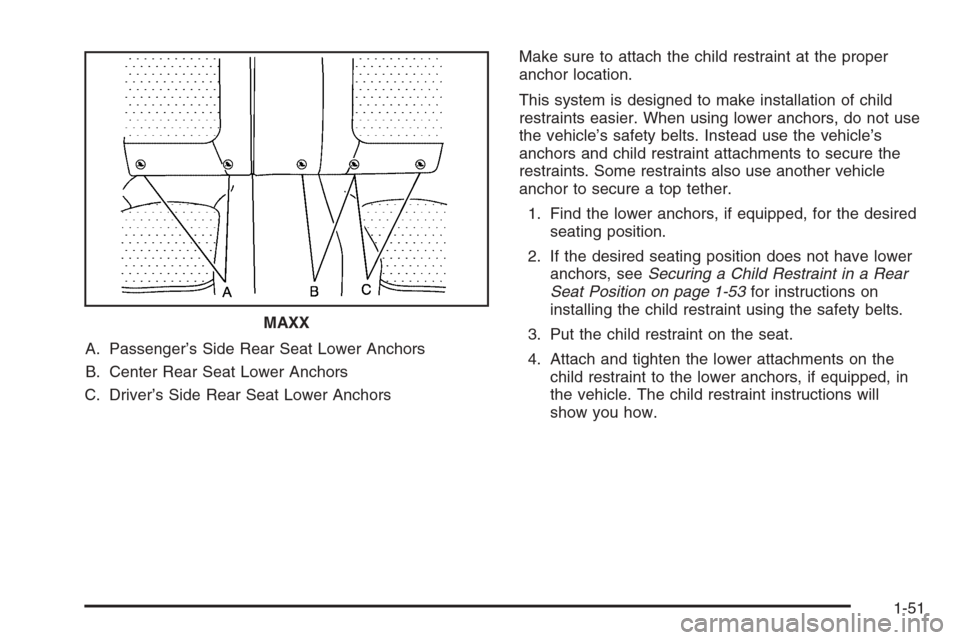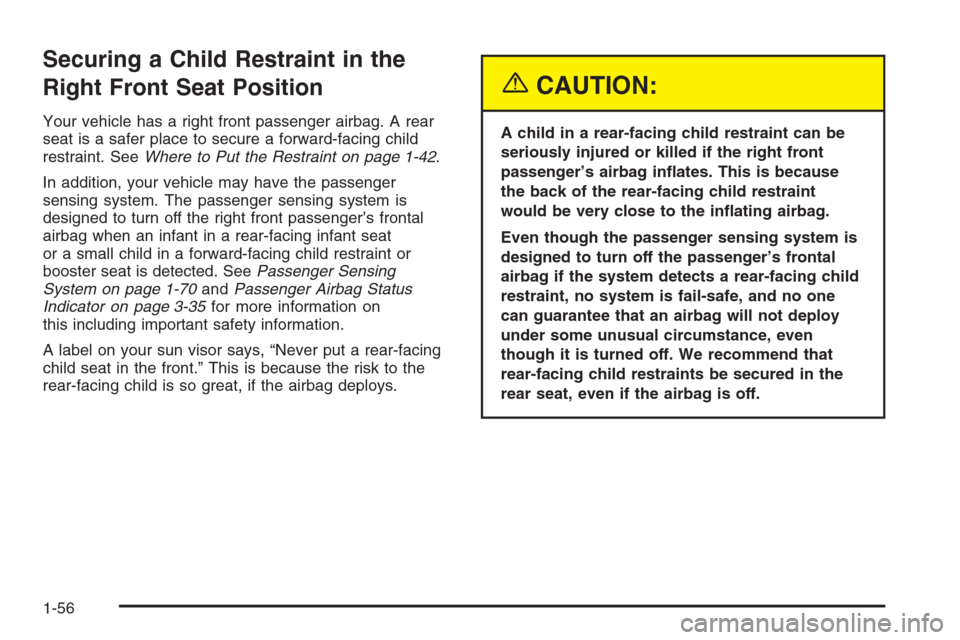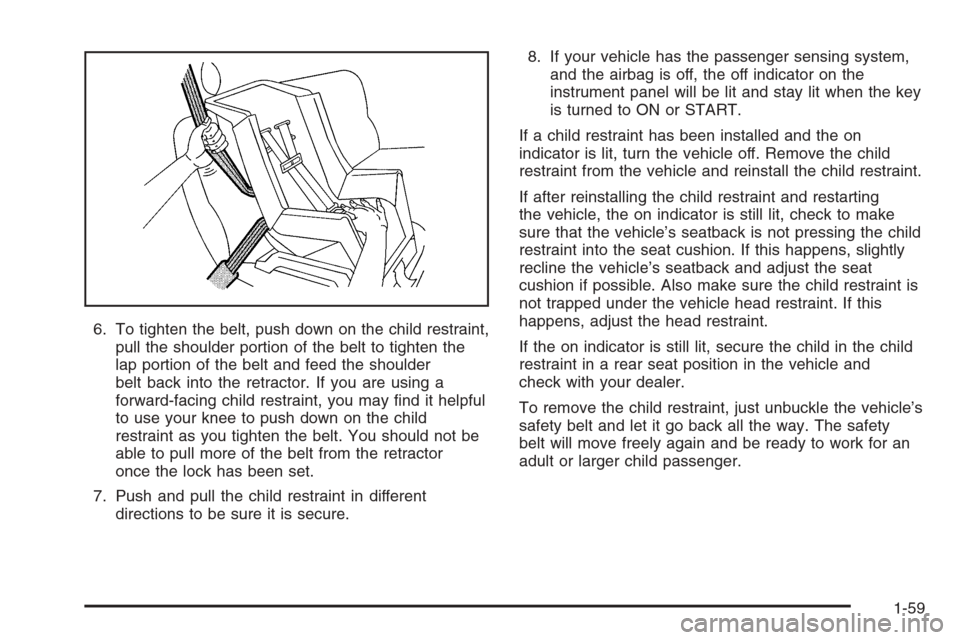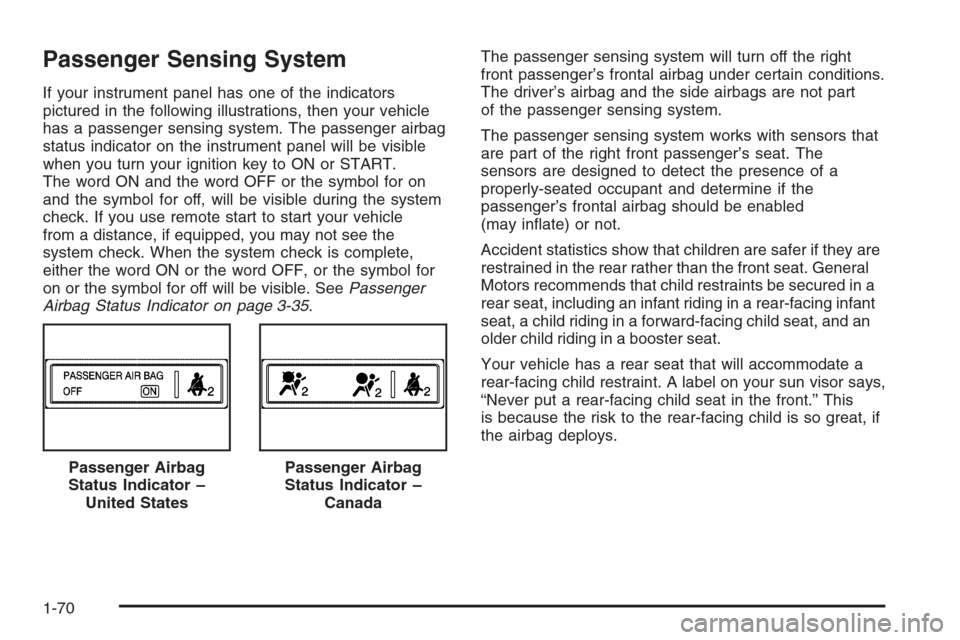Page 56 of 434
You cannot secure three child restraints using the
LATCH anchors in the rear seat at the same time, but
you can install two of them. If you want to do this, install
one LATCH child restraint in the passenger-side
position, and install the other one either in the
driver’s-side position or in the center position. Refer to
the following illustration to learn which anchors to use.
A. Passenger’s Side Rear Seat Lower Anchors
B. Center Rear Seat Lower Anchors
C. Driver’s Side Rear Seat Lower AnchorsSedan
1-50
Page 57 of 434

A. Passenger’s Side Rear Seat Lower Anchors
B. Center Rear Seat Lower Anchors
C. Driver’s Side Rear Seat Lower AnchorsMake sure to attach the child restraint at the proper
anchor location.
This system is designed to make installation of child
restraints easier. When using lower anchors, do not use
the vehicle’s safety belts. Instead use the vehicle’s
anchors and child restraint attachments to secure the
restraints. Some restraints also use another vehicle
anchor to secure a top tether.
1. Find the lower anchors, if equipped, for the desired
seating position.
2. If the desired seating position does not have lower
anchors, seeSecuring a Child Restraint in a Rear
Seat Position on page 1-53for instructions on
installing the child restraint using the safety belts.
3. Put the child restraint on the seat.
4. Attach and tighten the lower attachments on the
child restraint to the lower anchors, if equipped, in
the vehicle. The child restraint instructions will
show you how. MAXX
1-51
Page 58 of 434
5. If the child restraint is forward-facing, attach and
tighten the top tether to the top tether anchor.
Refer to the child restraint instructions and
the following steps:
5.1. Find the top tether anchor.
5.2. Route and tighten the top tether according to
your child restraint instructions and the
following instructions:
If the position you are
using does not have a
head restraint and you are
using a single tether,
route the tether over the
seatback.
If the position you are
using does not have a
head restraint and you are
using a dual tether,
route the tether over the
seatback.If the position you are using has an adjustable
head restraint and you are using a single or dual
tether, raise the head restraint and route the tether
under the head restraint and in between the
head restraint posts. SeeHead Restraints on
page 1-6.
6. Push and pull the child restraint in different
directions to be sure it is secure.
1-52
Page 59 of 434
Securing a Child Restraint in a Rear
Seat Position
If your child restraint is equipped with the LATCH
system, seeLower Anchors and Tethers for
Children (LATCH) on page 1-45.
If your child restraint does not have the LATCH system,
you will be using the lap-shoulder belt to secure the
child restraint in this position. Be sure to follow the
instructions that came with the child restraint. Secure
the child in the child restraint when and as the
instructions say.
1. Put the child restraint on the seat.
2. Pick up the latch plate, and run the lap and shoulder
portions of the vehicle’s safety belt through or
around the restraint. The child restraint instructions
will show you how.Tilt the latch plate to adjust the belt if needed.
1-53
Page 62 of 434

Securing a Child Restraint in the
Right Front Seat Position
Your vehicle has a right front passenger airbag. A rear
seat is a safer place to secure a forward-facing child
restraint. SeeWhere to Put the Restraint on page 1-42.
In addition, your vehicle may have the passenger
sensing system. The passenger sensing system is
designed to turn off the right front passenger’s frontal
airbag when an infant in a rear-facing infant seat
or a small child in a forward-facing child restraint or
booster seat is detected. SeePassenger Sensing
System on page 1-70andPassenger Airbag Status
Indicator on page 3-35for more information on
this including important safety information.
A label on your sun visor says, “Never put a rear-facing
child seat in the front.” This is because the risk to the
rear-facing child is so great, if the airbag deploys.
{CAUTION:
A child in a rear-facing child restraint can be
seriously injured or killed if the right front
passenger’s airbag in�ates. This is because
the back of the rear-facing child restraint
would be very close to the in�ating airbag.
Even though the passenger sensing system is
designed to turn off the passenger’s frontal
airbag if the system detects a rear-facing child
restraint, no system is fail-safe, and no one
can guarantee that an airbag will not deploy
under some unusual circumstance, even
though it is turned off. We recommend that
rear-facing child restraints be secured in the
rear seat, even if the airbag is off.
1-56
Page 63 of 434

If you need to secure a forward-facing child restraint in
the right front seat position, move the seat as far
back as it will go before securing the forward-facing
child restraint. SeeManual Seats on page 1-2.
If your child restraint is equipped with the LATCH
system, seeLower Anchors and Tethers for
Children (LATCH) on page 1-45.
There is no top tether anchor in the right front
passenger’s position. Do not secure a child restraint in
this position if a national or local law requires that a
top tether be anchored or if the instructions that come
with the child restraint say that the top tether must
be anchored. SeeLower Anchors and Tethers
for Children (LATCH) on page 1-45if your child restraint
has a top tether.You will be using the lap-shoulder belt to secure the
child restraint in this position. Be sure to follow the
instructions that came with the child restraint. Secure
the child in the child restraint when and as the
instructions say.
1. Your vehicle has a right front passenger’s frontal
airbag. SeePassenger Sensing System on
page 1-70. General Motors recommends that
rear-facing child restraints be secured in a rear seat,
even if the airbag is off. If your child restraint is
forward-facing, move the seat as far back as it will
go before securing the child restraint in this
seat. SeeManual Seats on page 1-2.
When the passenger sensing system has turned off
the right front passenger’s frontal airbag, the off
indicator in the passenger airbag status indicator
should light and stay lit when you turn the ignition to
ON or START. SeePassenger Airbag Status
Indicator on page 3-35.
2. Put the child restraint on the seat.
3. Pick up the latch plate, and run the lap and shoulder
portions of the vehicle’s safety belt through or
around the restraint. The child restraint instructions
will show you how.
1-57
Page 65 of 434

6. To tighten the belt, push down on the child restraint,
pull the shoulder portion of the belt to tighten the
lap portion of the belt and feed the shoulder
belt back into the retractor. If you are using a
forward-facing child restraint, you may �nd it helpful
to use your knee to push down on the child
restraint as you tighten the belt. You should not be
able to pull more of the belt from the retractor
once the lock has been set.
7. Push and pull the child restraint in different
directions to be sure it is secure.8. If your vehicle has the passenger sensing system,
and the airbag is off, the off indicator on the
instrument panel will be lit and stay lit when the key
is turned to ON or START.
If a child restraint has been installed and the on
indicator is lit, turn the vehicle off. Remove the child
restraint from the vehicle and reinstall the child restraint.
If after reinstalling the child restraint and restarting
the vehicle, the on indicator is still lit, check to make
sure that the vehicle’s seatback is not pressing the child
restraint into the seat cushion. If this happens, slightly
recline the vehicle’s seatback and adjust the seat
cushion if possible. Also make sure the child restraint is
not trapped under the vehicle head restraint. If this
happens, adjust the head restraint.
If the on indicator is still lit, secure the child in the child
restraint in a rear seat position in the vehicle and
check with your dealer.
To remove the child restraint, just unbuckle the vehicle’s
safety belt and let it go back all the way. The safety
belt will move freely again and be ready to work for an
adult or larger child passenger.
1-59
Page 76 of 434

Passenger Sensing System
If your instrument panel has one of the indicators
pictured in the following illustrations, then your vehicle
has a passenger sensing system. The passenger airbag
status indicator on the instrument panel will be visible
when you turn your ignition key to ON or START.
The word ON and the word OFF or the symbol for on
and the symbol for off, will be visible during the system
check. If you use remote start to start your vehicle
from a distance, if equipped, you may not see the
system check. When the system check is complete,
either the word ON or the word OFF, or the symbol for
on or the symbol for off will be visible. SeePassenger
Airbag Status Indicator on page 3-35.The passenger sensing system will turn off the right
front passenger’s frontal airbag under certain conditions.
The driver’s airbag and the side airbags are not part
of the passenger sensing system.
The passenger sensing system works with sensors that
are part of the right front passenger’s seat. The
sensors are designed to detect the presence of a
properly-seated occupant and determine if the
passenger’s frontal airbag should be enabled
(may in�ate) or not.
Accident statistics show that children are safer if they are
restrained in the rear rather than the front seat. General
Motors recommends that child restraints be secured in a
rear seat, including an infant riding in a rear-facing infant
seat, a child riding in a forward-facing child seat, and an
older child riding in a booster seat.
Your vehicle has a rear seat that will accommodate a
rear-facing child restraint. A label on your sun visor says,
“Never put a rear-facing child seat in the front.” This
is because the risk to the rear-facing child is so great, if
the airbag deploys.
Passenger Airbag
Status Indicator –
United States
Passenger Airbag
Status Indicator –
Canada
1-70